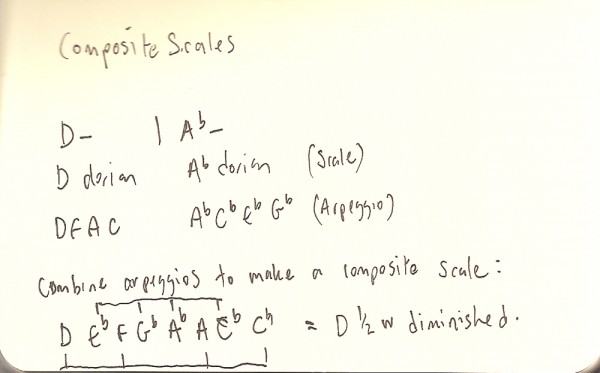Here’s an idea that came from a student at The Arden Centre a good few years ago; I think his name was Ben Shaw. Could’ve been someone else though. Anyhow, there was a tune that had a couple of chords, perhaps like the chords above, that were from two different keys. I was explaining that you could use the arpeggio or the scale to highlight the sound of the chord. Making the changes stuff.
Then he says, ‘why don’t you mix up the notes to get one scale that fits both chords’.
Good idea!
So here, you take the 7th chord arpeggios of D-7 and Ab-7 and arrange them as a scale, and that gives you the D diminished scale.
Try other chord progressions:
E.g., C Ab E gives you triads of CEG, AbCEb, EG#B. Arrange that lot in order and you get: C D# E G Ab B, which is the C Augmented scale.
Try: F- D-
Try: C∆ A∆
If you come up with anything that’s nice, feel free to keep it to yourself and don’t share it in the comments box below AT ALL. Don’t do that, because I will steal it, just like I did this chap’s idea from 20 years ago, and post it here on the Internet and take ALL, YES, ALL THE GLORY!

Thanks, Joe. Your last couple of post were in my spam filter. Don’t know why. But I guess now I’ve told it that you’re a real person, it’ll respond in the right way.
That pattern sounds bonkers!
I’m off to play Apache ;)
M
So here is something interesting I been noodling on for a while.
If we take strings 2,3,4 and 5, play notes in this consecutive order C,Ab, Eb (first fret) and A (open).
We then imagine the first fret is a mirror and reverse the pattern, going up a fret playing C#, A, E (second fret) and C (3rd fret), then reverse the pattern again, E, C, G, (fifth fret), C# (fourth fret), again, F,C#,Ab (6th fret) E (7th fret), again, Ab,E,B(9th fret) F(8th fret), and so on. We just continue inverting the pattern. All positions can be played with 2 fingers, as the 2,3 and 4 strings are always barred, 1 finger, the other finger to play the 5th string, which is the one doing the jumping around.
At first, what was peculiar about this is that the physical pattern had a logic sound pattern behind it, although I was not able to recognize it. It had to be some sort of symmetrical scale though, based on the implied order.
So, in doing a bit of analysis, turns out that the sound pattern is indeed a scale discovered by the great Olivier Messiaen, one of the series of what he called “scales of limited transposition”, this one in particular is known as M3.
The tones of the scale are 1,2,3m, 3,5b, 5,5#, 7m,7. In other words, no 6th or 4th degrees.
This gives us a scale which has both a major and minor 3rd, cool, like the half diminished, but the best bit is that it also has a natural 7th and a minor seventh, which is were it gets interesting.
So, some really outrageous patterns can be derived from this, it contains the augmented scale within, and also the cycle of major thirds, aka the Coltrane steps, so it is great to use over those type of sounds and also over static key centers when some organized, yet outside movement is desired in the solos.
Hopefully somebody will be able to make some sense out of it and enjoy it.
Cheers,
Joe